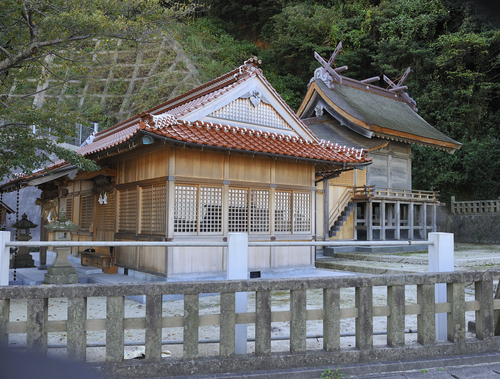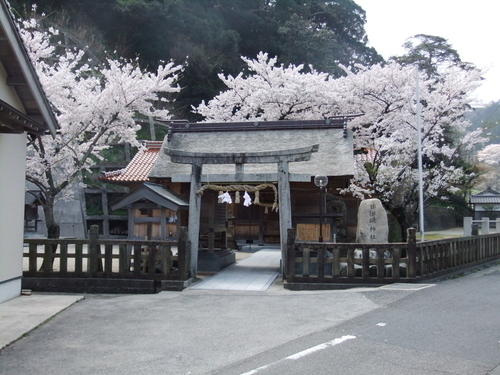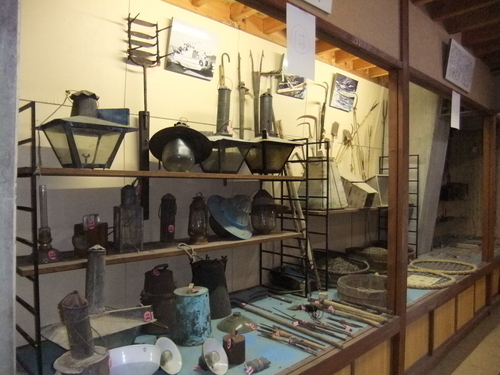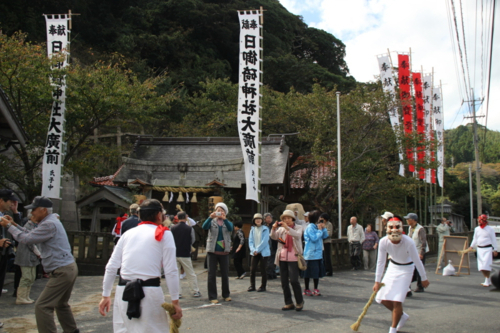Nonami-ura
| Bay Name | Nonami-ura |
|---|---|
| Shrine Name |
Hinomisaki-jinja (Current) Hinomisaki Daijingu (Former) |
| Deity |
Amaterasu Oomikami Takehaya Susano O no mikoto |
| Location |
Matsue-shi Shimane-cho Nonami 313 (Aza Inogaya) |
Nonami ura Hinomisaki Daijingu
Okinonami uchikuru shio no kiyokereba
Musubu kokoro no soko mo suzushiki

Perusing the Fudoki will give an account of Nonami as 'Nonami no Hama (beach), 1144 feet wide. Shrine at eastern side of beach. Dwellings can be seen.' The beach stretches along 370m. The shrine of Nonami beach at that time was enshrined in the east of the beach. Currently, the shrine at the most western point of Nonami beach is Hinomisaki-jinja.
It's not known when the kanjo (transfer of the kami to a new location) took place from Hinomisaki jinja in Taisha machi , however it is said that after this, the kami was first transferred to the island Oshima, but was washed away by a tidal wave in the late 16th century, and ended up drifting ashore to its current location. Those worshipping in Nonami ura in the early 1700's would have prayed at the shrine called, 'Hinomisaki Daijingu'. This was the first location following the transfer, but later on the kami was also shared with Kasa ura, Sezaki, Sadahongo, and the smaller Oashi and Chikumi. There is still more research to be done to clarify the finer points of this kanjo (transfer) process.
During the time of Bunsei, (1818-1830) when Kanezaki Zenbei visited Nonami, the shrine he recorded was 'Suga jinja', but these days there is no mention of this name in relation to Nonami. However, up to the end of the Meiji era near the location of the current public hall in Aza Maeda, there was a shrine called Hiyoshi jinja which had a shared kami with a Sugahori jinja. The actual location name, 'maeda' contains the word 'mae' (before) . This is thought to refer to being 'before/in front of the gods', so it's possible that the Sugahori jinja was indeed the same shrine as the Suga jinja from the Bunsei era.
In 1909, Sugahori jinja and Hiyoshi jinja were merged with Hinomisaki jinja in the west but the name Suga hosato is no longer referenced. It's possible the 'shrine in the west' written in the Fudoki was referring to this location in Aza Maeda or it could be the name long forgotten yet present in the Fudoki, 'Nunami no yashiro'.

The path leading from Kaka-jinja to the Nonami shrine is along the old road , a route lined with seven hundred sakura, (cherry blossom) trees known as 'Cherry Road'. In Heisei 6 (1994), this road was selected by the committee as an entry for the ' 100 roadside tree views in Japan'. It's a perfect reminder of spring in Matsue.
Arriving at Hinomisaki-jinja in Nonami, as expected, you'll be greeted by a prayer hall enveloped in cherry blossom trees, almost as if they were the guardian deity of Cherry Road.
Hinomisaki has a ritual event, 'Otaue jinji'. An annual occasion held on January 7th held to pray for prosperity and family/household safety. Participants, wearing a cow mask , dangling a mochi (rice cake) from the mouth like a tongue, walk around the inside of the prayer hall. Shibamaki leaves are scattered about and then participants of all ages and both genders thrash about in an attempt to gather? the leaves using a hoe style tool made? of bamboo. It's a lively affair which attracts participants from outside the local area too.
In addition, Hinomisaki holds the 'Gacchi festival' every October 23rd where the locals wear various masks and tap the shrine visitors on the behind.
Gacchi is said to be another festival along with the 'Gion shashin kosai' held as a chance for the kami of Hiyoshi jinja, formerly located in Gogenyama, to return to its original location. Hiyoshi jinja was enshrined together with Hinomisaki jinja in 1909, so the kami has a chance to go 'home' once a year each autumn.
Whether the Gacchi festival is some kind of disturbance connected to the sometime malevolent enshrined deity , Susanoo, or it's the guidance of Amaterasu protecting her surroundings, is not known, but the name Gacchi, is said to have maybe originated from the old location name 'Kachi' near to Hiyoshi shrine.
Heading from the shrine past Nonami ura bathing area will take you to the 'Shimane Town Historical Folklore Archive Hall'. While it may look a little neglected, it contains around two thousand articles from back in the handmade days showing how everyday life used to be including fishing equipment, wooden and clay figures. With permission from Shimane mach public hall, these items can be viewed. Similar collections of items can be viewed around Shimane Peninsula in places like the Mihonoseki History, Lifestyle Experience Hall' and 'Taisha machi Public Archives Room'.


| Bay Name | Nonami-ura |
|---|---|
| Shrine Name |
Hinomisaki-jinja (Current) Hinomisaki Daijingu (Former) |
| Deity |
Amaterasu Oomikami Takehaya Susano O no mikoto |
| Location |
Matsue-shi Shimane-cho Nonami 313 (Aza Inogaya) |
Nonami ura Hinomisaki Daijingu
Okinonami uchikuru shio no kiyokereba
Musubu kokoro no soko mo suzushiki
Perusing the Fudoki will give an account of Nonami as 'Nonami no Hama (beach), 1144 feet wide. Shrine at eastern side of beach. Dwellings can be seen.' The beach stretches along 370m. The shrine of Nonami beach at that time was enshrined in the east of the beach. Currently, the shrine at the most western point of Nonami beach is Hinomisaki-jinja.
It's not known when the kanjo (transfer of the kami to a new location) took place from Hinomisaki jinja in Taisha machi , however it is said that after this, the kami was first transferred to the island Oshima, but was washed away by a tidal wave in the late 16th century, and ended up drifting ashore to its current location. Those worshipping in Nonami ura in the early 1700's would have prayed at the shrine called, 'Hinomisaki Daijingu'. This was the first location following the transfer, but later on the kami was also shared with Kasa ura, Sezaki, Sadahongo, and the smaller Oashi and Chikumi. There is still more research to be done to clarify the finer points of this kanjo (transfer) process.
During the time of Bunsei, (1818-1830) when Kanezaki Zenbei visited Nonami, the shrine he recorded was 'Suga jinja', but these days there is no mention of this name in relation to Nonami. However, up to the end of the Meiji era near the location of the current public hall in Aza Maeda, there was a shrine called Hiyoshi jinja which had a shared kami with a Sugahori jinja. The actual location name, 'maeda' contains the word 'mae' (before) . This is thought to refer to being 'before/in front of the gods', so it's possible that the Sugahori jinja was indeed the same shrine as the Suga jinja from the Bunsei era.
In 1909, Sugahori jinja and Hiyoshi jinja were merged with Hinomisaki jinja in the west but the name Suga hosato is no longer referenced. It's possible the 'shrine in the west' written in the Fudoki was referring to this location in Aza Maeda or it could be the name long forgotten yet present in the Fudoki, 'Nunami no yashiro'.
The path leading from Kaka-jinja to the Nonami shrine is along the old road , a route lined with seven hundred sakura, (cherry blossom) trees known as 'Cherry Road'. In Heisei 6 (1994), this road was selected by the committee as an entry for the ' 100 roadside tree views in Japan'. It's a perfect reminder of spring in Matsue.
Arriving at Hinomisaki-jinja in Nonami, as expected, you'll be greeted by a prayer hall enveloped in cherry blossom trees, almost as if they were the guardian deity of Cherry Road.
Hinomisaki has a ritual event, 'Otaue jinji'. An annual occasion held on January 7th held to pray for prosperity and family/household safety. Participants, wearing a cow mask , dangling a mochi (rice cake) from the mouth like a tongue, walk around the inside of the prayer hall. Shibamaki leaves are scattered about and then participants of all ages and both genders thrash about in an attempt to gather? the leaves using a hoe style tool made? of bamboo. It's a lively affair which attracts participants from outside the local area too.
In addition, Hinomisaki holds the 'Gacchi festival' every October 23rd where the locals wear various masks and tap the shrine visitors on the behind.
Gacchi is said to be another festival along with the 'Gion shashin kosai' held as a chance for the kami of Hiyoshi jinja, formerly located in Gogenyama, to return to its original location. Hiyoshi jinja was enshrined together with Hinomisaki jinja in 1909, so the kami has a chance to go 'home' once a year each autumn.
Whether the Gacchi festival is some kind of disturbance connected to the sometime malevolent enshrined deity , Susanoo, or it's the guidance of Amaterasu protecting her surroundings, is not known, but the name Gacchi, is said to have maybe originated from the old location name 'Kachi' near to Hiyoshi shrine.
Heading from the shrine past Nonami ura bathing area will take you to the 'Shimane Town Historical Folklore Archive Hall'. While it may look a little neglected, it contains around two thousand articles from back in the handmade days showing how everyday life used to be including fishing equipment, wooden and clay figures. With permission from Shimane mach public hall, these items can be viewed. Similar collections of items can be viewed around Shimane Peninsula in places like the Mihonoseki History, Lifestyle Experience Hall' and 'Taisha machi Public Archives Room'.






